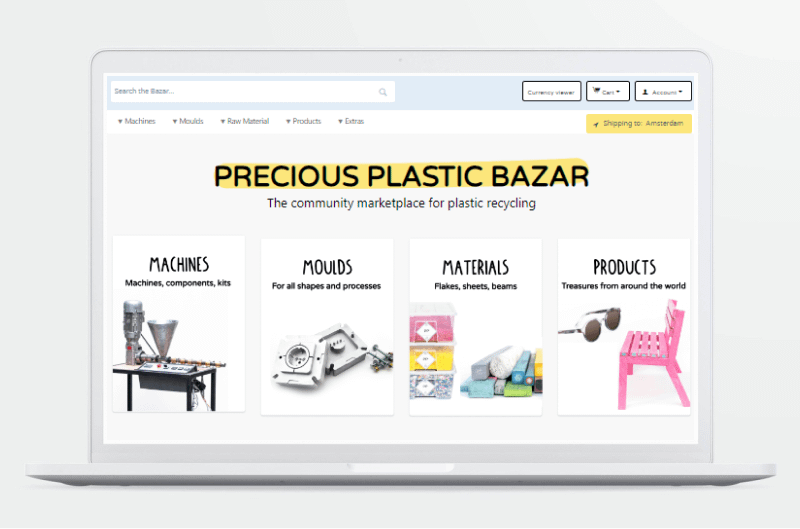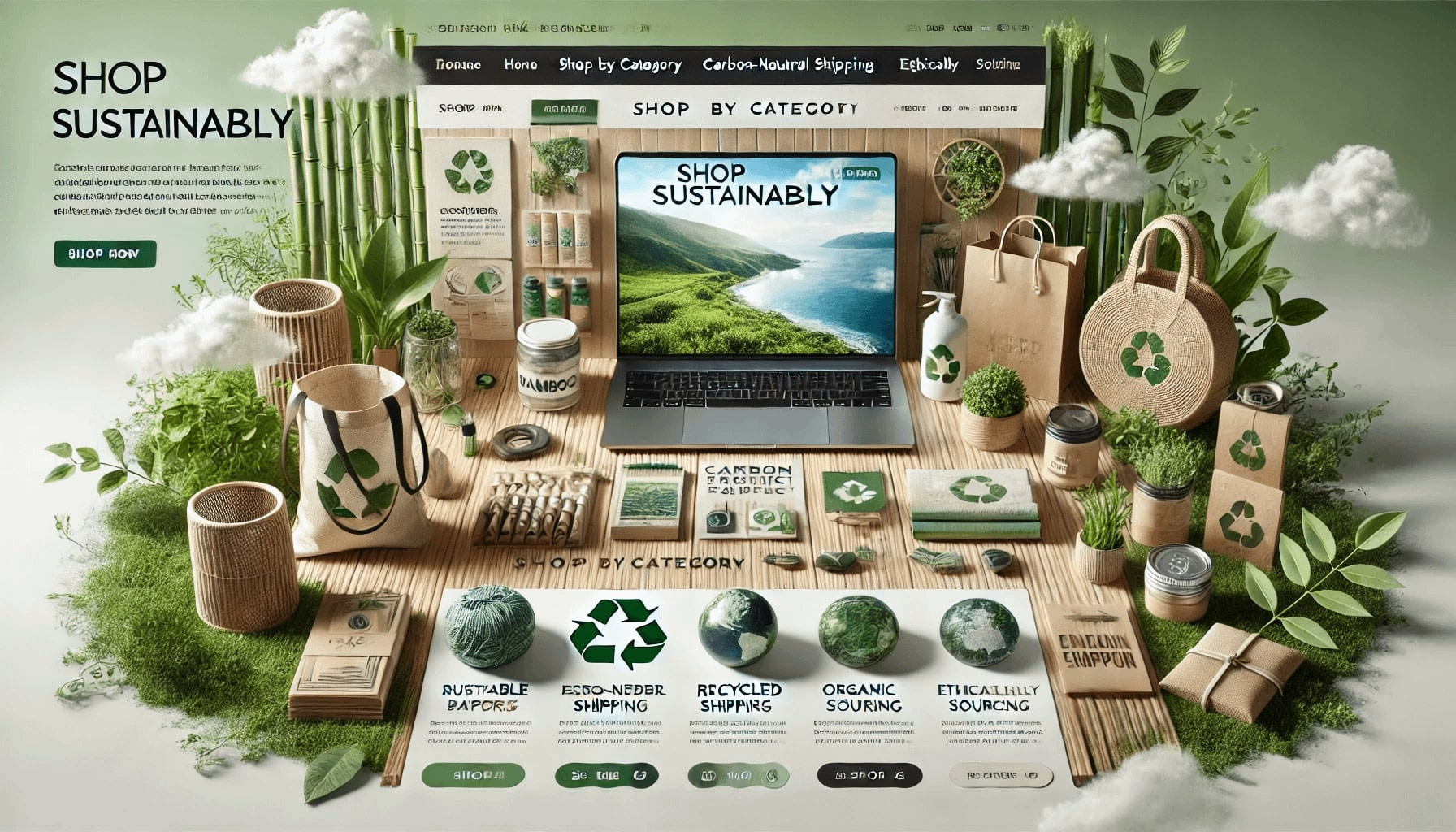As eCommerce continues to surge, accounting for over 20% of global retail sales, the need for sustainable practices has never been more pressing. With 73% of consumers willing to change their online shopping environmental impact, businesses must adapt to this shift. As we explore the nuances of sustainable eCommerce, we’ll uncover why sustainable practices are essential for both business success and environmental stewardship.
2. Implement sustainable practices in logistics and packaging: Successful online brands are adopting eco-friendly solutions, such as carbon-neutral shipping and sustainable packaging for eCommerce. For example, companies like Amazon have introduced electric delivery vans, while brands like EcoEnclose offer biodegradable mailers and recycled boxes.
3. Follow the example of eco-conscious eCommerce leaders: Companies like Patagonia and Allbirds showcase the power of sustainable business models by integrating renewable energy, ethical sourcing, and carbon offset initiatives. These examples highlight how adopting tools and practices for sustainable eCommerce not only reduces environmental impact but also builds consumer trust and loyalty.
What Is Sustainable eCommerce?
Sustainable eCommerce refers to the practice of conducting online business in a way that minimizes environmental impact and promotes social responsibility. As the shift towards sustainable online shopping accelerates, it is essential for businesses to adopt sustainable practices that not only benefit the planet but also resonate with eco-conscious consumers. This includes considerations of sustainable eCommerce packaging, ethical sourcing, and overall eCommerce sustainability.
Why is Eco-Business Important?
Sustainability in eCommerce is crucial for several reasons. First, eco-commerce addresses the growing concern over climate change and environmental degradation. As consumers become more aware of their purchasing decisions, they increasingly favor brands that prioritize sustainability.
Additionally, adopting eco-friendly practices can lead to cost savings, improved brand loyalty, and a competitive edge in the marketplace. Just like revenue enablement aligns teams around shared financial goals, sustainable eCommerce aligns operations around long-term environmental and brand value. This shift has given rise to sustainable retailers and sustainable eCommerce brands that focus on responsible retail.
How Does Online Shopping Affect the Environment?
While eCommerce may initially seem like a greener alternative to traditional retail, it still has a significant environmental footprint. The carbon emissions associated with data centers, logistics, and packaging contribute to climate change. Data centers consume about 20% of the world’s electricity, and with the increasing complexity of websites, this consumption is expected to rise.
Furthermore, the logistics of shipping products can lead to increased greenhouse gas emissions, especially when relying on fossil fuel-powered transportation. Understanding how online shopping affects the environment is essential for addressing these issues.
Online shopping can be sustainable. It can reduce the carbon footprint associated with traditional retail by minimizing the need for physical store operations and allowing consumers to compare earth-friendly options more easily.
However, the environmental impact of shipping and returns can offset these benefits if not managed properly. Ultimately, the sustainability of online shopping hinges on the choices consumers make, the practices of the retailers they support, and the efficiency of logistics involved in delivering products.
Key Challenges for Sustainable eCommerce Business
Transitioning to a sustainable eCommerce model is increasingly essential for businesses that want to stay relevant in a world focused on reducing environmental impact. However, achieving sustainability often comes with its own set of challenges, from financial barriers to logistical hurdles. Below, we outline key challenges and offer practical strategies to overcome them, helping businesses balance profitability with responsible retail.
Higher Initial Costs
Sustainable materials and practices often require a higher upfront investment, whether it’s eco-friendly packaging or renewable energy sources.
How to Overcome: Focus on long-term savings and value creation. While initial costs may be higher, sustainable practices can reduce operational costs over time through energy efficiency, waste reduction, and consumer loyalty. Highlighting your commitment to sustainability can also increase customer engagement and brand value.
Supply Chain Complexity
Sourcing sustainable products and materials can complicate logistics, requiring extensive research and partnership-building to find ethical suppliers.
How to Overcome: Invest in building a transparent and reliable supply chain by collaborating with suppliers who prioritize sustainability. Utilize digital tools for supply chain management to streamline sourcing and logistics while ensuring eco-friendly standards are met. Innovations such as artificial intelligence and blockchain can help optimize supply chains and enhance transparency in sourcing.
Consumer Education
Convincing customers of the value of sustainable products can be a challenge, as many consumers are still learning about the environmental benefits of these options.
How to Overcome: Develop clear and compelling marketing campaigns that communicate the environmental and ethical impact of your products. Leverage certifications, eco-labels, and storytelling to build trust and educate consumers on how their choices can make a difference.

Eco-labels implemented by our developers for HumbleMarket
Balancing Profit and Responsibility
Maintaining profitability while prioritizing sustainability can be difficult, as environmentally friendly practices may initially appear to conflict with cost-cutting measures.
How to Overcome: Implement sustainable practices that align with your business goals and focus on efficiency. For instance, reducing waste, optimizing logistics, and adopting renewable energy can lower costs while improving your environmental impact. Moreover, customers are increasingly willing to pay a premium for sustainable products, which can help offset the initial expenses.

One of our clients advocates for sustainable shopping by encouraging consumers to choose handmade clothing from small, unique brands instead of mass-market retailers like Zara, highlighting the importance of supporting artisans who prioritize craftsmanship and community well-being.
Benefits of Using Ethical eCommerce for Your Business
Although the challenges of transitioning to a sustainable eCommerce model can be significant, the benefits far outweigh the obstacles.
- Enhanced Brand Loyalty: Consumers are more likely to support brands that demonstrate a commitment to sustainability.
- Cost Savings: Implementing energy-efficient practices can reduce operational costs.
- Market Differentiation: Sustainable practices can set your business apart from competitors.
- Compliance and Risk Management: Adopting sustainable practices can help mitigate regulatory risks and improve compliance with environmental laws.
Tools for Measuring and Reducing Carbon Footprint
One of the first steps in overcoming eco-business challenges is understanding your carbon footprint. Accurately measuring the emissions your business generates is essential for identifying areas where improvements can be made.
Let’s explore the most powerful tools designed to help businesses of all sizes measure and reduce their carbon footprint.
WebsiteCarbon.com

Results of our website
- Purpose: Measures the carbon emissions of your website, providing insights into CO2 output per page and annual electricity consumption.
- Benefit: Helps you understand your site’s environmental impact and whether it’s hosted on a green data center.
Google Page Speed Insights

- Purpose: Analyzes the performance of your website and provides suggestions for improving speed and efficiency.
- Benefit: Faster sites typically consume less energy and improve user experience.
GTmetrix

Example of a performance report
- Purpose: Offers detailed reports on your website’s performance, including load times and data transfer metrics.
- Benefit: Identifies areas for optimization to reduce data transfer and improve efficiency.
EcoPing

- Purpose: EcoPing measures the carbon emissions generated by websites, helping businesses track the environmental impact of their digital operations.
- Benefit: It enables businesses to reduce emissions by optimizing website performance, improving user experience, and supporting sustainability efforts.
TinyPNG/TinyJPG

- Purpose: Compresses images without losing quality.
- Benefit: Reduces the size of images, leading to lower data transfer and faster loading times.
EcoGrader

Results for our website
- Purpose: To assess your website’s carbon footprint.
- Benefit: A well-optimized site can significantly reduce energy consumption by minimizing data transfer and improving load times.
Green Web Foundation

Results for our website
- Purpose: A resource for finding hosting providers that use renewable energy.
- Benefit: Helps you select a green hosting provider, reducing your site’s carbon footprint.
Strategies to Make Your eCommerce Website More “Green”
Image Optimization
Use tools like TinyPNG to compress images. If your website has 100 images averaging 500 KB each, optimizing them could reduce total data transfer from 50 MB to 10 MB, significantly speeding up load times.
Code Cleanliness
Write efficient code or utilize existing solutions that minimize data requests. Regularly audit your website’s codebase for unnecessary scripts and optimize them to improve loading efficiency.
Learn more from our articles:
- Choosing the Right eCommerce Backend for Your Project: Popular Solutions and Features
- How to Build eCommerce Tech Stack
Green Hosting
Opt for hosting providers that use renewable energy. Research providers like GreenGeeks or A2 Hosting, and verify their energy sources. If you switch to a provider that uses 100% renewable energy, you can significantly lower your site’s carbon footprint.
Multi-Storefront Solutions
If managing multiple sites, use a multi-storefront solution to reduce redundancy and optimize resources. Platforms like CS-Cart allow you to manage multiple storefronts from a single dashboard, reducing the need for separate hosting and resources for each site. Learn more from our article: Top 5 Questions About Multiple Storefronts
Regular Performance Monitoring
Use tools like Google PageSpeed Insights and GTmetrix to track performance metrics and make necessary adjustments. Action: Set a quarterly schedule to review your site’s performance and implement suggested optimizations. After using GTmetrix to identify slow-loading pages, you may find that optimizing certain scripts can improve load times by 30%.

Eco-Friendly Online Store Development
Enhance your online visibility with robust applications for eCommerce. We create high-performance, eco-friendly, and green-hosted web and mobile online stores and hypermarkets that engage and retain green-minded customers.
Educating Users
Share your sustainability efforts on your site. Create a dedicated page or blog section highlighting your green practices and their impact. Use storytelling to explain how switching to renewable energy has reduced your carbon footprint, fostering a deeper connection with eco-conscious customers.
Utilizing Renewable Energy Certificates (RECs)

If direct control over energy use is limited, consider purchasing RECs to offset your carbon emissions. Research reputable organizations that sell RECs and commit to purchasing a certain amount annually. By purchasing RECs equivalent to your estimated annual emissions, you can
Get more tips and tools from our article How to Reduce Your Carbon Footprint with eCommerce Sites: Online Stores and Marketplaces
How Can Retailers Be More Sustainable?
Let’s explore some examples of world leaders that apply sustainability in their business, to inspire to repeat their success.
Sustainable Packaging eCommerce

EcoEnclose offers eco-friendly eCommerce packaging solutions, such as biodegradable mailers and recycled boxes. By using their products, businesses can reduce plastic waste and environmental impact.
Energy-Efficient Practices

Patagonia is a sustainable eCommerce website that utilizes renewable energy sources for its operations, including solar panels in its stores and distribution centers.
They switched to energy-efficient appliances and lighting in their physical locations and partnered with green hosting providers that use renewable energy to power their data.
Local Sourcing

Farmgirl Flowers sources its flowers from local farms, reducing transportation emissions and supporting local economies.
Eco-Friendly Products

Seventh Generation offers cleaning and personal care products made from plant-based ingredients and sustainable materials. To repeat their success, you can expand your product range and include eco-friendly products made from sustainable materials or those that promote earth-friendly practices, such as reusable bags or biodegradable utensils.
Waste Reduction Initiatives

IKEA has committed to becoming a circular business by 2030, focusing on reusing and recycling materials in its products. They are implementing a take-back program for customers to return used products for recycling or repurposing.
Carbon Offsetting
Allbirds offsets its carbon footprint by investing in renewable energy projects and reforestation initiatives. Using tools like EcoGrader, you can also calculate your business’s carbon emissions and invest in carbon offset programs to balance out your environmental impact.
Sustainable Transportation

Amazon has introduced electric delivery vans to reduce emissions from its delivery fleet. You can also collaborate with logistics providers that use electric or hybrid vehicles for shipping. Encourage customers to choose slower shipping options to consolidate deliveries, reducing the overall carbon footprint.
Examples of Successful Eco-Businesses Made with CS-Cart
PreciousPlastic Bazar

Precious Plastic Bazar, launched in the Netherlands in 2013 by designer Dave Hakkens, is a marketplace dedicated to reducing plastic waste by enabling individuals to recycle plastic into various products. Collaborating with Simtech Development, they customized the Multi-Vendor platform to straightforward shipping rates based on regions. Enhancements included file attachments in the Real-Time Messenger for better communication and displaying vendor names and countries on product listings to foster trust. These initiatives have created a user-friendly C2C marketplace that supports eco-conscious entrepreneurs and promotes sustainability.
WatchStyle

WatchStyle, a leading supplier of high-end replacement watch bands based in Germany, sought to enhance its online customer service by improving website performance. With over 10,000 items in stock and shipping to 96 countries, the company faced challenges in mobile and desktop load speeds. We conducted a comprehensive performance analysis, addressing issues like render-blocking code, optimizing Redis session management, and implementing HTML minification and image compression. As a result, the website’s loading speed improved by 58% on mobile and 34% on desktop, significantly enhancing user experience and satisfaction.
Conclusion
Sustainable eCommerce is not just a trendy word; it is an essential aspect of modern business that addresses environmental and social challenges. By implementing sustainability in the retail industry, businesses can reduce their carbon footprint, enhance brand loyalty, and contribute positively to the planet.
Embracing concepts like zero waste, slow fashion, and fair trade can further enhance a company’s commitment to a sustainable future.
Simtech Development can handle the technical aspects of greening eCommerce websites, allowing digital entrepreneurs to focus on implementing sustainable business practices.
FAQ about Sustainable Commerce
Is there a difference between sustainable practices of B2B and B2C companies within the context of sustainability?
Yes, there are differences between the sustainable practices of B2B (Business-to-Business) and B2C (Business-to-Consumer) companies. B2C companies often focus on appealing to individual consumers by emphasizing eco-friendly products, transparent sourcing, and ethical marketing to attract environmentally conscious buyers. In contrast, B2B companies prioritize sustainability in terms of operational efficiency, cost-effectiveness, and regulatory compliance, often optimizing their supply chains and partnering with sustainable suppliers. While B2C brands highlight sustainability in their marketing to build consumer loyalty, B2B firms leverage sustainable practices as a competitive advantage in long-term partnerships. Read more: B2B vs B2C: Leveraging Key Differences and Merging Opportunities.
What does the term “Earth Hero” refer to, and what actions do they typically take to promote environmental sustainability?
An “Earth Hero” typically refers to an individual or organization that actively works to protect the environment and promote sustainability. This can include a wide range of actions, such as advocating for conservation, reducing waste, supporting renewable energy initiatives, and educating others about environmental issues. Earth Heroes can be everyday people making small changes in their lives, activists fighting for policy changes, or organizations leading large-scale environmental campaigns. The term emphasizes the positive impact individuals can have in contributing to a healthier planet.
Can you provide examples of sustainable products?
Examples of eco-friendly products include reusable shopping bags made from organic cotton or recycled materials, biodegradable packaging solutions like compostable mailers, and eco-friendly personal care items such as shampoo bars and bamboo toothbrushes. Additionally, clothing made from organic or recycled fabrics, like those offered by brands such as Patagonia and Reformation, exemplifies sustainable fashion. Other examples include energy-efficient appliances, solar-powered gadgets, and cleaning products made from plant-based ingredients, like those from Seventh Generation. These products not only reduce environmental impact but also promote a more sustainable lifestyle for consumers.
What role does eco marketing play in promoting sustainable products?
Eco Marketing plays a crucial role in promoting sustainable products by leveraging digital channels to reach environmentally conscious consumers effectively. It encompasses strategies such as content marketing, social media campaigns, and targeted advertising that highlight the eco-friendly attributes of products, such as ethical sourcing and minimal environmental impact. By using eco marketing techniques, brands can educate consumers about the benefits of sustainable choices, foster a community around environmental responsibility, and ultimately drive sales. This approach not only enhances brand loyalty but also contributes to a broader movement towards sustainability in the marketplace.
How can small businesses effectively implement sustainable practices without significant financial burdens?
Small businesses can start by making incremental changes, such as reducing packaging waste, sourcing locally, and using energy-efficient appliances. Collaborating with other local businesses to share resources and knowledge can also help minimize costs while maximizing sustainability efforts.
What are the future trends in sustainable eCommerce?
Technological innovations will drive more efficient logistics and eco-friendly practices, while regulatory changes may enforce stricter sustainability standards, requiring businesses to adapt. Additionally, more companies will adopt circular economy models, focusing on reducing waste and reusing materials to create a more sustainable eCommerce business ecosystem.

